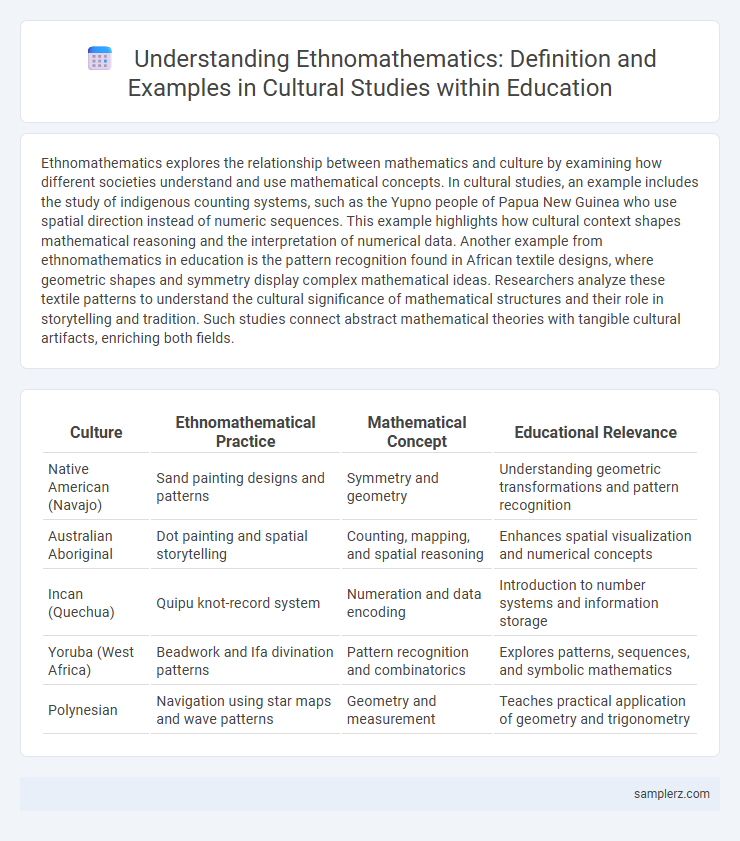Ethnomathematics explores the relationship between mathematics and culture by examining how different societies understand and use mathematical concepts. In cultural studies, an example includes the study of indigenous counting systems, such as the Yupno people of Papua New Guinea who use spatial direction instead of numeric sequences. This example highlights how cultural context shapes mathematical reasoning and the interpretation of numerical data. Another example from ethnomathematics in education is the pattern recognition found in African textile designs, where geometric shapes and symmetry display complex mathematical ideas. Researchers analyze these textile patterns to understand the cultural significance of mathematical structures and their role in storytelling and tradition. Such studies connect abstract mathematical theories with tangible cultural artifacts, enriching both fields.
Table of Comparison
| Culture | Ethnomathematical Practice | Mathematical Concept | Educational Relevance |
|---|---|---|---|
| Native American (Navajo) | Sand painting designs and patterns | Symmetry and geometry | Understanding geometric transformations and pattern recognition |
| Australian Aboriginal | Dot painting and spatial storytelling | Counting, mapping, and spatial reasoning | Enhances spatial visualization and numerical concepts |
| Incan (Quechua) | Quipu knot-record system | Numeration and data encoding | Introduction to number systems and information storage |
| Yoruba (West Africa) | Beadwork and Ifa divination patterns | Pattern recognition and combinatorics | Explores patterns, sequences, and symbolic mathematics |
| Polynesian | Navigation using star maps and wave patterns | Geometry and measurement | Teaches practical application of geometry and trigonometry |
Indigenous Counting Systems: A Global Perspective
Indigenous counting systems, such as the Yup'ik base-20 system in Alaska, the Oksapmin body counting method in Papua New Guinea, and the quipu knotted strings of the Inca civilization, illustrate diverse mathematical concepts embedded within cultural contexts. These systems demonstrate unique numeric representations and calculation techniques that differ significantly from Western base-10 arithmetic, highlighting the importance of cultural perspectives in mathematical education. Understanding these ethnomathematical practices fosters inclusivity and enriches global numerical literacy by connecting mathematical knowledge to indigenous heritage and cognitive frameworks.
Symbolism in Traditional Mathematical Practices
Traditional African beadwork exemplifies ethnomathematics by incorporating intricate geometric patterns that symbolize societal roles and cosmological beliefs. These bead patterns use specific shapes and color sequences reflecting mathematical concepts such as symmetry, tessellation, and modular arithmetic. Studying such symbolism reveals how indigenous cultures embed mathematical reasoning within cultural identity and communication.
Ethnomathematics in Native American Basket Weaving
Ethnomathematics in Native American basket weaving reveals intricate geometric patterns and symmetry used to create functional and symbolic designs. These traditional techniques incorporate mathematical concepts such as fractals, tessellations, and spatial reasoning embedded in cultural storytelling and heritage. Understanding these patterns provides insight into indigenous knowledge systems, blending art, mathematics, and cultural identity.
Measurement Systems in African Cultures
Measurement systems in African cultures, such as the use of body parts for units of length among the Yoruba and the traditional Maasai cattle counting methods, exemplify ethnomathematics by integrating indigenous knowledge with mathematical concepts. These culturally embedded systems reflect practical applications of geometry, estimation, and numeracy tailored to community needs and environmental context. Understanding these indigenous measurement practices enhances the appreciation of diverse mathematical worldviews and promotes culturally responsive education in mathematics.
Geometry in Islamic Art and Architecture
Islamic art and architecture prominently feature geometric patterns that exemplify ethnomathematics by blending mathematical principles with cultural expression. The intricate tessellations and symmetrical designs found in mosques and palaces demonstrate advanced use of geometry, specifically employing concepts such as symmetry, repetition, and tessellation. These patterns reflect the cultural emphasis on order and unity, revealing how mathematical concepts are embedded in the artistic and architectural heritage of Islamic societies.
Navigation and Mathematics in Polynesian Voyages
Polynesian voyagers used complex geometrical concepts and celestial navigation to traverse vast ocean distances without modern instruments, exemplifying ethnomathematics in cultural study. Their knowledge of star paths, wave patterns, and island topography combined traditional mathematical reasoning and practical navigation skills. This integration of mathematics in cultural practices highlights the deep indigenous understanding of spatial relationships and environmental observation.
Mathematical Patterns in Andean Textiles
Andean textiles exhibit complex geometric patterns that reflect sophisticated mathematical concepts such as symmetry, tessellation, and fractals, illustrating the deep integration of mathematics in indigenous cultural practices. These patterns are not only artistic expressions but also encode numerical systems and cultural knowledge, providing insight into the mathematical thinking of Andean communities. Ethnomathematics studies these textile designs to reveal how traditional societies use mathematical principles in practical and symbolic ways, enriching the understanding of cultural heritage and education.
Number Concepts in Aboriginal Australian Traditions
Aboriginal Australian traditions demonstrate unique number concepts exemplified through ethnomathematics, where numerical understanding is deeply embedded in storytelling, kinship systems, and land navigation. These complex counting systems utilize body parts, natural cycles, and spatial orientation rather than abstract numerals. Such approaches reveal how indigenous knowledge systems provide alternative frameworks for quantitative reasoning grounded in cultural practices.
Mathematical Games and Puzzles in Cultural Contexts
Ethnomathematics explores mathematical concepts embedded in cultural practices, such as traditional board games like Mancala, which teach strategic thinking and counting skills. These mathematical games and puzzles reflect complex patterns, spatial reasoning, and combinatorial logic unique to specific cultural contexts. Studying these games provides insights into diverse cognitive frameworks and enriches cross-cultural understanding of mathematical ideas.
Ethnomathematics in Everyday Cultural Practices
Ethnomathematics examines how indigenous communities use patterns, measurements, and spatial reasoning in daily activities like weaving, cooking, and trading, revealing sophisticated mathematical concepts embedded in cultural traditions. For instance, Native American beadwork involves geometric symmetry and fractals, while African basket weaving demonstrates complex algorithms and proportional reasoning. These everyday practices highlight the integration of cultural knowledge with mathematical thought, enriching educational approaches by valuing diverse cognitive frameworks.

example of Ethnomathematics in cultural study Infographic
 samplerz.com
samplerz.com